Grumman F4F-4 Wildcat
Grumman's Wildcat was the first of the Grumman cats (Wildcat, Hellcat, Tigercat, Bearcat, Tomcat) to enter service with the US Navy back in 1940. It was the backbone of the USN fighter fleet during the early years of World War 2 and continued to serve until the end of conflict. While inferior in capabilities compared to its Pacific arch enemy, the Mitsubishi A6M Zero, the tactics developed made it a formidable fighter with a 5.9:1 kill to loss ratio in 1942 and 6.9:1 during the whole war. The experiences gained with the aircraft helped Grumman to design its much improved succesor, the F6F Hellcat. Almost 8.000 Wildcats were built.
British Fleet Air Arm operated nearly 1.200 Wildcats of different versions during the WW2 in the Atlantic and Far East areas of operation. They were used in variety of roles, often operating from small escort carriers and fighting Fw200s and Ju-88s attacking allied shipping convoies, but were also used as ground attack aircraft. The US Navy and Marine Corps use is of course more straightforward and better known, with aircraft tasked anything from islands protection (mainly by USMC) to participating in all the major naval battles from 1941 onwards.
John S. Thach
Thach was a US Navy pilot that helped create the so called Thatch Weave manuever, which helped the inferior but sturdy Wildcats successfully oppose the superior performing Zeros by using cooperative manuevering. In early 1940, Thatch became the commander of fighting squadron VF-3 bearing the ‘Felix the Cat' symbol. There he met and set up as his wingman a young pilot named Edward O'Hare and though him everything he knew. O'Hare later became Medal of Honor recipient but unfortunately didn't survive the war. Chicago's international airport bares his name. VF-3 was mainly assigned to USS Saratoga but during the Battle of Midway, Thatch and the boys were relocated to USS Yorktown. During the first mission of the day, Thach was leading an escort flight for the Devastators, which located the Japanese fleet and was jumped by a larger number of Zeros. Using his manuever for the first time in combat, he returned from the flight with 3 kills and his wingman with another, for the loss of one Wildcat. Later he would shoot down
After the Battle of Midway, Thatch was pulled off combat duties to instruct new pilots. In 1944, when the Kamikaze attacks begun, he invented the ‘big blue blanket' system, which helped to mitigate the problem.
After the World War II he commanded a couple of carriers and later comanded an anti-submarine warfare unit. He was promoted to vice admiral in 1960, became Deputy Chief of Naval Operations and later in 1965 promoted to his final rank of full Admiral and served as Commander in Chief of Naval Forces Europe until his retirement in 1967.
The kit
This is my first Arma Hobby kit and since I've heard nothing but praises, I was eager to try it out. And there's really not much fault with it. Details are excellent, in the cockpit as on the outside. Landing gear assembly is a bit tricky, but with some care and dryfitting shouldn't be too difficult to build. Two-piece cowling fits perfectly so I decided to attach it with some blue-tac during the painting and paint the engine separately. I did the full riveting job on the aircraft as I felt the details were missing a bit on the fuselage (not much going there in terms of panel lines but there are some longitudinal rivet lines).
VF-3 received F4F-4s shortly before the Battle of Midway so I kept the weathering restrained.
Link to the in-progress article: https://imodeler.com/groups/work-in-progress-aircraft/forum/topic/midway-80th-anniversary-duo-172-armahobby-f4f-4-wildcat-flyhawk-sbd-3-dauntless/
Model Data
Company: Arma Hobby / 700047
Scale: 1:72
Aftermarket: none
Paints used: Mr.Paint
Camouflage: MRP-133 Blue-Grey, MRP-134 Light Grey
Metallic surfaces: MRP-008 Duraluminium, MRP-147 Burnt Iron
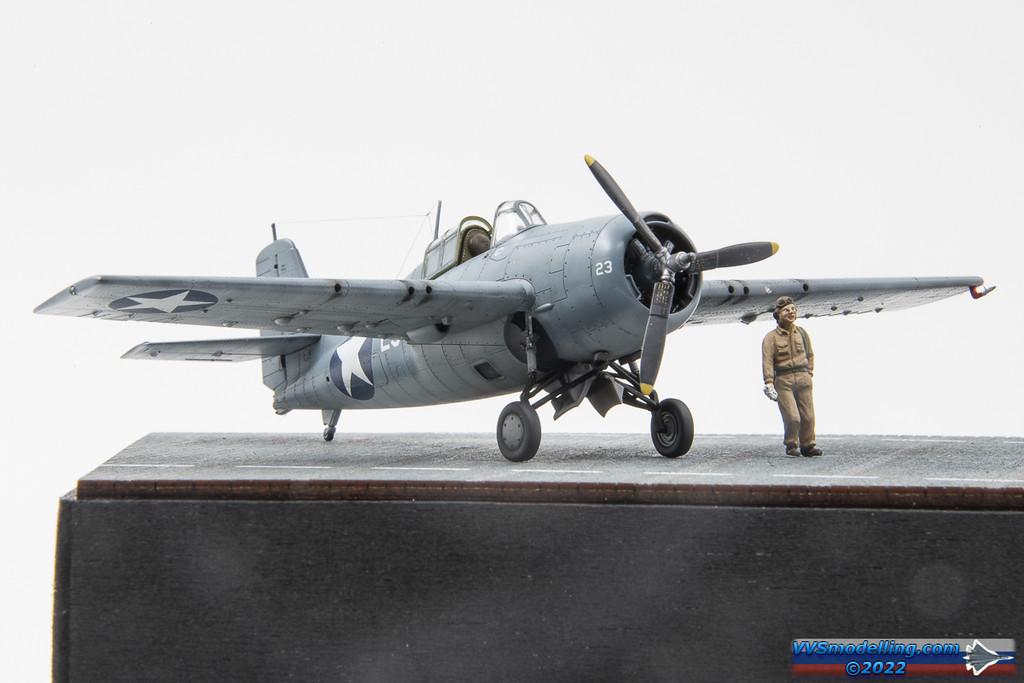
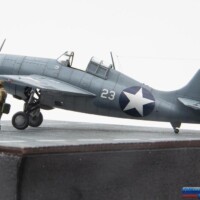

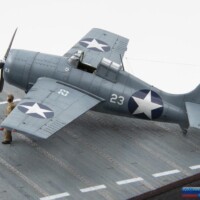
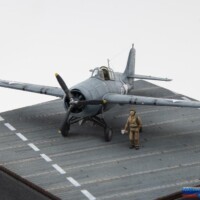

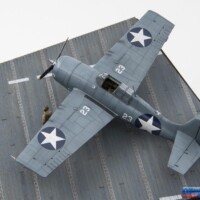
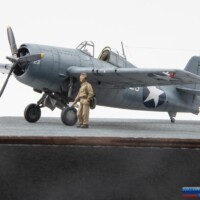
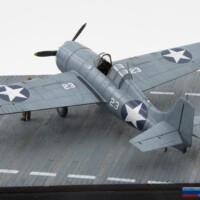
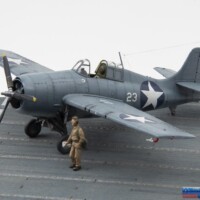
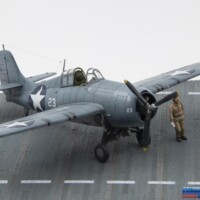
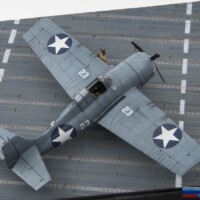
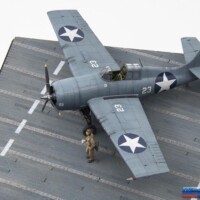
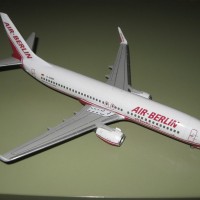
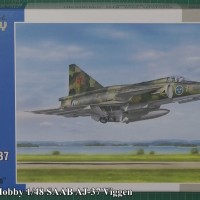

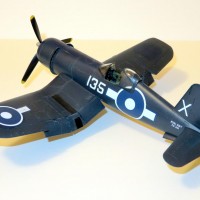
Well done, Sebastijan! An unbelievable result for the scale!
Thank you very much, Spiros!
Beautifully built and presented, Sebastijan, your photographs show off the model very well.
Thank you very much, George!
Nice work, Sebastijan. I thought it was 1/48.
Thank you very much, John!
I second the comments. It is hard to think it is not in 1/48!
Thank you very much, Marcello!
I too thought it was at least 1/48th, great job!
Thank you very much, Robert!
Great-looking Wildcat! The rivet work looks great, and nice paint and finishing as well.
Thank you very much, Greg! I find riveting a tedious job, but in the end, it's always worthy.
Ditto from me, Sebastijan (@inflames). Model looks great, as does the paint and decals. Well done.
Thank you very much, George!
A fantastic build, Sebastijan @inflames
To achieve these kind of results in 1/72 do require excellent modellings kills.
Well done.
Thank you very much, John. Building in this scale for whole my life certainly helps. As do Optivisors 😀
Nice job, Sebastijan. Almost makes me want to start building 1/72
Thank you very much, Gary! Why not? Some of these new kits in 1:72 are as good as larger scale counterparts or even better.
Sabastijan, At first glance I thought "oh, a nice Eduard 1/48 kit" then realized this was 1/72 scale.
You've done some really nice work here on this build.
Thank you very much, Terry!
Really a beautiful build. For me even more amazing that it is 1/72 scale, the paint and weathering work just make it look much bigger, if that makes sense. You were able to make the most of the detail in that scale to achieve that affect.
Thank you very much, Walt. Always trying to improve my models and I am really satisfied how this one (and a few I'll be posting soon) turned out.
Beautiful Wildcat, Sebastijan. Just the right amount of everything. I wish Arma Hobby would release some kits in 1/48. Still waiting for their Hurricane in that scale.
Thank you, Eric! Hope you'll get their 48 scale releases in not too distant future.
Very nice! Arma keeps blowing them away in 1/72.
Thank you, Tom! Yeah it was my first Arma kit and I was impressed. I also have their Finnish Hurri in stash and I am already itching to get the Yak-1b and La-5.
Nicely done, great looking Wildcat!
Thank you very much, Bob!
This is a great build of a great plane Sebastijan, well done. Really looks great and sits perfectly on that excellent base. Really need to try an Arma hobby kit.
@anothnyricco Anthony, thank you! Apart from a little fiddly landing gear assembly it's a great kit!